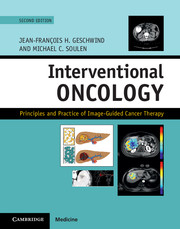Book contents
- Frontmatter
- Contents
- List of contributors
- Section I Principles of oncology
- Section II Principles of image-guided therapies
- Section III Organ-specific cancers – primary liver cancers
- Section IV Organ-specific cancers – liver metastases
- 16 Colorectal masses: Ablation
- 17 Assessment, triage, and chemoembolization for colorectal liver metastases
- 18 Radioembolization for colorectal liver metastases
- 19 Assessment, triage, and liver-directed therapies for neuroendocrine tumor metastases
- 20 Preoperative portal vein embolization
- Section V Organ-specific cancers – extrahepatic biliary cancer
- Section VI Organ-specific cancers – renal cell carcinoma
- Section VII Organ-specific cancers – chest
- Section VIII Organ-specific cancers – musculoskeletal
- Section IX Organ-specific cancers – prostate
- Section X Specialized interventional techniques in cancer care
- Index
- References
17 - Assessment, triage, and chemoembolization for colorectal liver metastases
from Section IV - Organ-specific cancers – liver metastases
Published online by Cambridge University Press: 05 September 2016
- Frontmatter
- Contents
- List of contributors
- Section I Principles of oncology
- Section II Principles of image-guided therapies
- Section III Organ-specific cancers – primary liver cancers
- Section IV Organ-specific cancers – liver metastases
- 16 Colorectal masses: Ablation
- 17 Assessment, triage, and chemoembolization for colorectal liver metastases
- 18 Radioembolization for colorectal liver metastases
- 19 Assessment, triage, and liver-directed therapies for neuroendocrine tumor metastases
- 20 Preoperative portal vein embolization
- Section V Organ-specific cancers – extrahepatic biliary cancer
- Section VI Organ-specific cancers – renal cell carcinoma
- Section VII Organ-specific cancers – chest
- Section VIII Organ-specific cancers – musculoskeletal
- Section IX Organ-specific cancers – prostate
- Section X Specialized interventional techniques in cancer care
- Index
- References
Summary
The prognosis of patients with colorectal carcinoma rests largely on the presence or absence of distant metastases. In 2013, there were an estimated 142,820 new cases of colon cancer in the USA, with a prevalence of over 1.1 million and 50,830 annual deaths from the disease. Twenty percent of newly diagnosed patients already have metastases, and many more develop metastatic disease over time. The liver is the first and most common site, with 80% of stage IV patients having liver involvement and 40% of patients dying with the liver as their only site of metastases. Among patients with extrahepatic disease, more than half still die from liver failure. Resection of liver metastases improves long-term survival; however, for the 75% of patients who are not resectable, palliative treatments to delay cancer progression to fatal liver failure is the standard of care.
Assessment of the patient with liver metastases
Initial assessment of the patient with colorectal liver metastases incorporates the history and physical examination, review of laboratory studies including tumor markers, diagnostic imaging, and pathology. Performance status is an important prognostic factor, since patients with declining function (Eastern Cooperative Oncology Group (ECOG) > 2) tend not to benefit from liver-directed therapies despite being otherwise eligible to receive them.
High-quality anatomic and functional imaging is key for treatment planning and subsequent response assessment. Reports of diagnostic imaging studies alone do not provide the level of detail needed for triage and treatment planning. The interventional oncologist should carefully review anatomic imaging (computed tomography (CT) or magnetic resonance imaging (MRI)) to assess segmental tumor burden. The first question to answer is if the patient is resectable, or could be converted to resectability through multidisciplinary interventions such as downstaging, ablation, or portal vein embolization. Close collaboration with a surgical oncologist can lead to potentially curative treatment plans even for multifocal disease. For unresectable disease, analysis of the size, location, and distribution of metastases in the liver will guide treatment planning among ablation and embolotherapies. High-quality imaging also depicts classical or variant arterial anatomy, status of the bile ducts and portal veins, and presence of ascites or extrahepatic disease. Positron emission tomography (PET)-CT shows fluorodeoxyglucose (FDG)-avidity in the majority of patients with metastatic colorectal cancer and can be helpful in following treatment response for therapies where conventional Response Evaluation Criteria In Solid Tumors (RECIST) imaging is less useful, such as ablation and embolization.
- Type
- Chapter
- Information
- Interventional OncologyPrinciples and Practice of Image-Guided Cancer Therapy, pp. 148 - 157Publisher: Cambridge University PressPrint publication year: 2016



